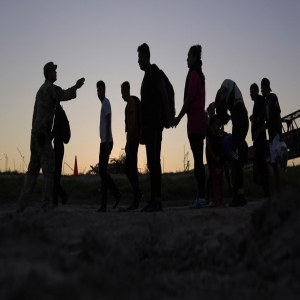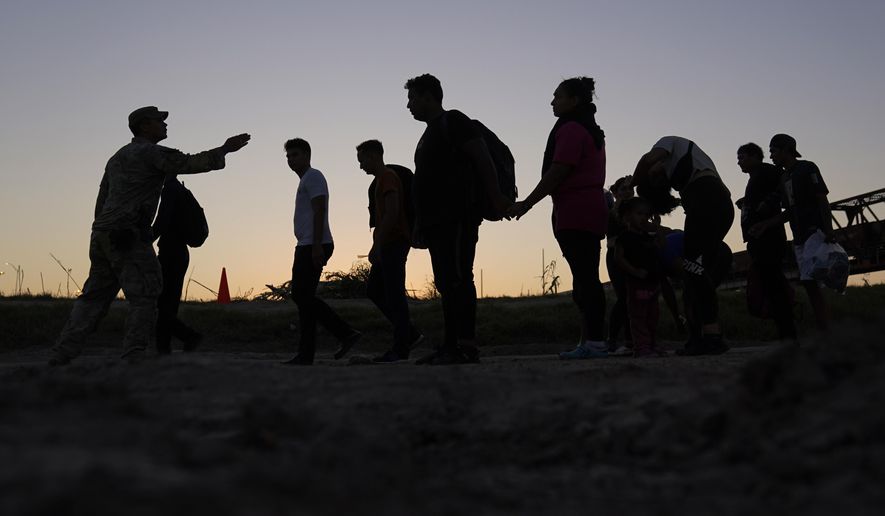
 A. J. Philip
A. J. Philip

We were seated in the last but two rows on an Air India flight from Paris to Delhi in the year 2000. After almost everyone had taken their seats and stored their luggage, two French policemen brought four or five young Indians in handcuffs. One sat next to me.
After a few minutes of waiting, just before the door was closed, the policemen returned, unlocked the handcuffs of the detainees, and left the plane. Immediately afterwards, the air hostess closed the door, and the flight took off.
I asked my new neighbour what had happened. He said they were cheated by the agent who brought them to Europe. They had destroyed their passports, as advised, when the police caught them. At that point, their leader told my neighbour not to talk to me. He obeyed.
The air hostesses treated them like any other passengers, serving them the same food and beverages. They were so tired that they fell asleep as soon as the plane became airborne. Yes, they were illegal immigrants being deported to their country of origin.
When the plane reached Delhi, some policemen came to the aircraft to take them away. I remembered this incident when I read reports of an American military aircraft, C-17, used to transport supplies and personnel, landing at Amritsar with 104 Indian deportees on board. Except for children, all others, including women, were chained and shackled.
One of the passengers, whose name I will not reveal, though it appeared in the mainstream media, was from the Kapurthala district in Punjab. She was accompanied by her 10-year-old son, for whose better future she paid Rs 1 crore to an agent to reach the American El Dorado.
She was told that it was a direct flight to the US. Instead, the mother and son were taken to Medellin in Colombia. After a two-week stay, they were taken to San Salvador, the capital of El Salvador. From there, they had to walk for three hours to reach Guatemala. From there, they were taken to the US-Mexico border. On the way, they lost their baggage.
While crossing the border, they were caught by the American border security force on January 27. They were shifted to a camp, where they had to remain for five days with virtually no food, as only meat was served. Then began the 40-hour ordeal on the C-17 aircraft, which stopped at several places for refuelling.
Since they were handcuffed and shackled, eating and using the toilet were difficult. A compassionate female crew member gave them fruits. They had no clue where they were headed until they reached Amritsar, where their chains and handcuffs were removed. After interrogation, the police took them to their native places.
In her case, Kapurthala, whose Sikh Maharaja had built a large, beautiful mosque for his subjects and had a Spanish wife. He had a large collection of diamond-studded watches and employed a person solely to key the watches once every 24 hours. She described her experience as nothing short of hellish. Her story reminded me of the Malayalam movie Comrade in America (CIA), released in 2017.
In the film, Aji Mathew, played by Dulquer Salman, falls in love with Sarah, played by Karthika Muralidharan, while she is visiting Kerala. She offers to get a visa for him, but he refuses, unwilling to associate with a capitalist country.
Months later, when word reaches that Sarah is being forced into marriage in the US, he decides to reach there before the wedding. With no time to get an official visa, he opts for an illegal route to America. He obtains a recommendation letter to the Communist Party in Cuba from the local party secretary in Kerala.
He travels through Latin America, eventually reaching the Mexican border after a perilous journey. Others are either detained or killed, but Aji reaches America only to find that Sarah has no time for him.
He has the option of staying in the US illegally but chooses to return, knowing he will never get an American visa. Valuing freedom, he leaves for India. On the plane, he meets Pallavi, a woman he had befriended during the hazardous journey. She is being deported to India but not in chains or shackles.
As president of the Kerala Club, I had the honour of releasing Bangladeshi writer Taslima Nasrina's book Chumban (Kiss) in Malayalam. It is an anthology of short stories. One of the stories is about a Bangladeshi man who illegally crosses the border, reaches Delhi, and starts a business that thrives, only to provoke jealousy among fellow businessmen and his neighbours.
They conspire against him, leading to his arrest and deportation. Upon returning to Bangladesh empty-handed, he realises that no one in the village recognises him, let alone helps him. The story is heart-rending.
While I was in Chandigarh, an RSS outfit led by a former police chief invited me to address a gathering. He wanted me to speak about alleged infiltration from Bangladesh. I spoke instead about migration. The story of civilisation is the story of migrations.
The Biblical story of Exodus, often seen as a divine tale of liberation, can also be viewed as a historical account of migration. It narrates the Israelites' journey from Egypt to the Promised Land, driven by hardship and the search for better living conditions, mirroring countless human migrations throughout history shaped by survival and hope.
People from Central Asia, often identified as Indo-Aryans, migrated to the Indian subcontinent around 1500 BCE, settling along the banks of the Indus River. They brought with them Vedic traditions, language, and rituals, which evolved into Hinduism, shaping the cultural and spiritual foundations of ancient Indian civilisation. The Sangh Parivar would not accept this, as it wants to claim that Hinduism is of Indian origin!
My speech did not sit well with the RSS, though I tried to answer their questions to the best of my ability.
Be that as it may, the picture of shackled Indians released by the American government did not show India in a good light. In fact, I consider it the most shameful image in post-Independence India. Previously, that title belonged to another image of an aircraft carrying the Reserve Bank of India's gold reserves to London for safekeeping when our fiscal reserves hit rock bottom.
I felt sad seeing the picture for several reasons. Just before the 2014 elections, Narendra Modi told a public meeting that people from countries like the US would queue for Indian visas. He promised to make India a favourite destination for people across continents.
Modi and Company now claim India has already become Vishwa Guru. God knows what that means. Meanwhile, massive neon-lit hoardings erected during the G-20 Summit remain in place, wasting power and mocking us all.
The Union Home Minister has been threatening to throw the infiltrators into the Bay of Bengal. He calls them termites, not even human beings. By comparison, Donald Trump's language has been milder; he calls them only illegal immigrants, not termites or green rats!
The American aircraft was allowed to land in Amritsar. Sixty-six out of the 104 deportees were from Gujarat and Haryana, which is two-thirds of the total. Ideally, the plane should have landed in Delhi or Ahmedabad. However, the diversion to Amritsar was intentional, giving the impression that a majority of the deportees were from Punjab.
Gujarat is one state from which the maximum number of people want to immigrate illegally. Occasionally, reports appear in the press about Gujaratis adopting innovative and dangerous ways to reach the US. They gave rise to the ex
Traditionally, migration has always flowed from poorer to richer countries. The US was not rich in the sixteenth century, but the British and other Europeans knew it was a land of opportunities. In the late 19th and early 20th centuries, Italians migrated to South America in search of better living conditions. That's how Pope Francis' forefathers reached Argentina.
Modi has been promoting the Gujarat model of progress. He once had the temerity to compare Kerala to Somalia. The fact is, it will take decades for Gujarat to catch up with Kerala in terms of education and quality of life. While a daily worker in Kerala earns about Rs 1,000 a day, his Gujarati counterpart earns only less than half of it.
The American aircraft exposed the myth of Gujarat's development model. There was a time when Bangladeshis wanted to migrate to India. Today, their economy is in much better shape. On social indices like literacy, women's literacy, infant mortality, maternal mortality, and spending on education and healthcare, Bangladesh is ahead of India.
I understand why the Americans restrained the deportees during the flight. They could have created a scene, attacked the crew, and caused a catastrophe. But could India not have averted the shameful flight? When Trump threatened to deport illegal immigrants to Mexico and Colombia, those countries refused to accept them or even provide airspace.
This forced Trump to change tactics — send them in passenger aircraft. India could have easily asked airlines like Air India or IndiGo to bring the deportees back on commercial terms. The American agencies would have removed the chains just before the planes took off. The ignominy could have been avoided.
Once, during the late Dr Manmohan Singh's tenure, an Indian diplomat posted in the US was arrested for allegedly mistreating her domestic help. She was even handcuffed. India protested and, in a tit-for-tat action, withdrew many facilities extended to the American Embassy at Chanakyapuri. Singh, of course, never claimed to have a 56-inch chest.
In the seventies, Indira Gandhi stood up to President Richard Nixon, who ordered the Seventh Fleet, headed by the aircraft carrier USS Enterprise, to move toward Kolkata. She declared that India would secure its ports and coastline if necessary. This forced Nixon to divert the fleet and averted a possible showdown.
The least Modi should have done was oppose the plan to send Indians back like cattle. A section of the media has been spreading misinformation that those deported were Hamas supporters or had committed serious crimes like tearing the American flag. This narrative aims to shore up the Modi government's shattered image. The fact is, many deportees had invested large sums to reach the US because they believed life in India was becoming increasingly difficult.
Modi once claimed Americans would queue up for Indian visas. He should visit the American Embassy in Delhi to see the growing queue of Indians seeking immigration. They aren't poor; they're wealthy.
Modi and Co. should think twice before calling human beings termites or threatening to dump them in the Arabian Sea. The Prime Minister would do well to remember how his US "friend" would have reacted if American citizens were humiliated abroad. He wouldn't have cared whether they were poor or low caste! Americans are Americans.
Similarly, the Indian government bears the responsibility to protect Indians' interests worldwide, regardless of social or economic standing. If countries like Panama, Mexico, Canada, Iran, and China can defend their sovereignty against Trump threats, why should India become a punching bag?
Let's hope Modi won't allow American aircraft to land in India in such a humiliating manner again. India must uphold its dignity and protect its citizens from degrading treatment, regardless of their immigration status. Standing firm against foreign pressure and asserting national sovereignty is essential to maintaining respect on the global stage. Meanwhile, let's stop calling ourselves Vishwa Guru!